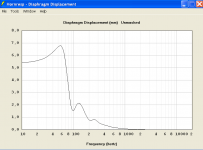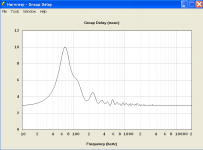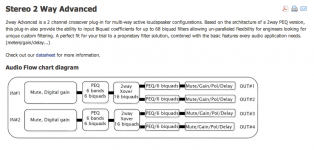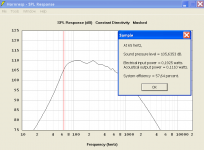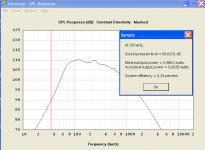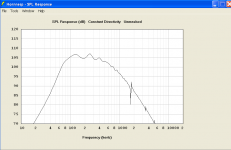the best solution i heard so far, to cover w/o crossover the range up to 800hz with low bass extension down to the thirties , and a horn/compression driver above, was a pair of Altec 416a's in Onken W cabinet :
my field coil driver - Page 4 - Audio Voice Acoustics
The Onken W - Audio Voice Acoustics
listening of such a system, is truly a amazing experience.
my field coil driver - Page 4 - Audio Voice Acoustics
The Onken W - Audio Voice Acoustics
listening of such a system, is truly a amazing experience.
Thanks for link. The video is great. It is quite interesting how even through my poor laptop speakers it is very easy to tell how good the speakers are. Sounds like the singer is in the room.
my field coil driver - Page 4 - Audio Voice Acoustics
my field coil driver - Page 4 - Audio Voice Acoustics
Last edited:
the best solution i heard so far, to cover w/o crossover the range up to 800hz with low bass extension down to the thirties , and a horn/compression driver above, was a pair of Altec 416a's in Onken W cabinet :
my field coil driver - Page 4 - Audio Voice Acoustics
The Onken W - Audio Voice Acoustics
listening of such a system, is truly a amazing experience.
Hello Angelo,
Your advising a huge mid horn and bas reflex (onken) sub and super tweeter.
The film lets hear a saxophone. It is like with a horn that voices and horn instruments aren't influenced by a good horn transducer. Both voice and brass instrument have a tunnel where the sound originates from. So with the good impulse behavior of a horn it is very real.
That isn't possible with a acceptable size horn as big as a washing machine. Like the la scala.Forgive me if this is a stupid question, but what about the range below 60-70 Hz? There's music up to at least 40 Hz, if not lower. Is the idea to put a shelf on the horn so that the response meets the efficiency at 40 Hz or so? Wouldn't the horn be unloaded in this region then?
I've been working on a similar design with a paper mache horn crossed in the 400-700 Hz region to a bass horn. Size is an issue though.
The horn construction as above has also horn loading below 60 hz but it is decreasing fast. It would bee a good solution to build it the dimension like I did post with the simulation and let it below 60Hz work like a close box and compensate the low active because the dynamic range of the use LF-driver is huge. Connect a DSP for your tube amp.
I make a simulation the driver will reach X-max (6,5mm) at 200W = 40V. It means 110dB at 30Hz enough to blow the living room and with 30Hz as -3dB the mean level can be 113dB at 1 meter.
Attachments
Last edited:
So I advise this sub active compensation dow to 30Hz. Advantage You can compensate the delay with the Dsp and have the huge sound of the bas mid horn of 1 meter and XO at 550Hz 48dB/oct. with this nice 2" driver of also 18sound.
Would make a cool 2way horn tranducer.
ND2060A - HF Neodymium Driver
Would make a cool 2way horn tranducer.
ND2060A - HF Neodymium Driver
An externally hosted image should be here but it was not working when we last tested it.
An externally hosted image should be here but it was not working when we last tested it.
An externally hosted image should be here but it was not working when we last tested it.
Last edited:
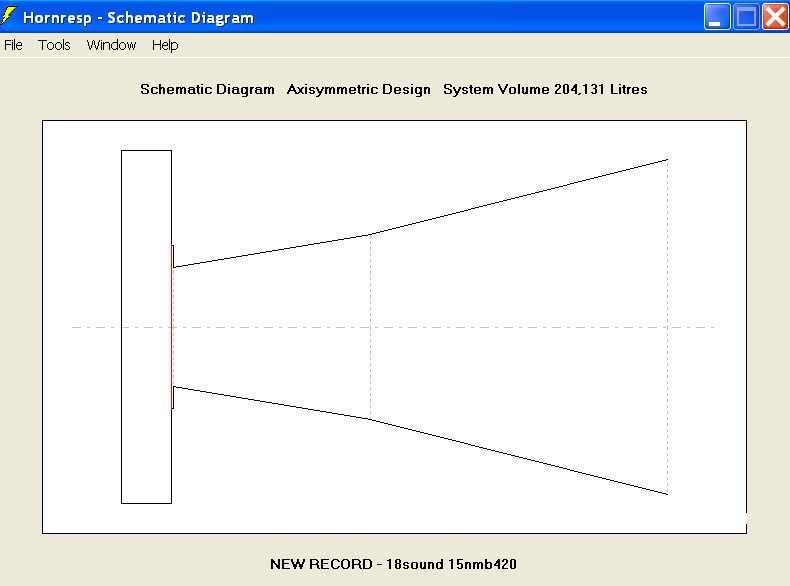
This horn folded like the klipsch la scala. A cube of (60cm X 60cm X 60cm) is enough. Big size but it is low 60cm it is the size of furnature.
With a nice 45cm wide mid/high horn and 28cm high we would have 90cm perfect ear height.
JBl 2386 2"
http://www.jblpro.com/pages/pub/components/2386.pdf
An externally hosted image should be here but it was not working when we last tested it.
Probably the 2380A is much better choice.
http://www.jblpro.com/pages/pub/components/2380a.pdf
Lynn I hope you have inspiration enough now to build the two way super la scala 30-20kHz.
Last edited:
Hello Angelo,
Your advising a huge mid horn and bas reflex (onken) sub and super tweeter.
The film lets hear a saxophone. It is like with a horn that voices and horn instruments aren't influenced by a good horn transducer. Both voice and brass instrument have a tunnel where the sound originates from. So with the good impulse behavior of a horn it is very real.
hi Helmut
Marios speakers sound excellent, despite the fact the design goes against what i would call orthodox : not time aligned drivers ( it didnt disturb or bother me ),a hudge horn used only above 800hz ( i asked Mario why , and he told me sound was a little " darker " ), and a bass and midbass do die for ( The altec's have great transients ). It was the first time i heard a JBL 2482 mid compression driver. I read somewhere these sound a little forward, and a little harsh. I didn't have this impression at all. They were sounding very relaxed , no listening fatigue. The tweeter was surprisingly good for its price, but i thought it a little agressive, and didnt integrate better because not time aligned.
The whole system sounds very organic and full. Just wonderful.....
Last edited:
hi Helmut
Marios speakers sound excellent, despite the fact the design goes against what i would call orthodox : not time aligned drivers ( it didnt disturb or bother me ),a hudge horn used only above 800hz ( i asked Mario why , and he told me sound was a little " darker " ), and a bass and midbass do die for ( The altec's have great transients ). It was the first time i heard a JBL 2482 mid compression driver. I read somewhere these sound a little forward, and a little harsh. I didn't have this impression at all. They were sounding very relaxed , no listening fatigue. The tweeter was surprisingly good for its price, but i thought it a little agressive, and didnt integrate better because not time aligned.
The whole system sounds very organic and full. Just wonderful.....
It is the question how sensitive we are to phase faults smaller in time then the "Haas effect".http://en.wikipedia.org/wiki/Haas_effect
But if we aren't sensitive to it it will cause not linearity of the response. that wee can hear.
Or the faulty time alignment causes a special stereo effect. I know that the auricle (ears) has a shape that causes sound to travel direct to the tympanic membrane and others to travel though the channels in the auricle. Due this time alignment we can pin point the direction of sound.
What i want to say is that the faulty time alignment maybe causes the same sound effects and causes you to think you hear something special.
Last edited:
I don't know what experience others have had, but for me, playing around with the phase and polarity has made me realize how important it is for reproduction of the original spacial perception. I am not talking about what the listening room can create, but rather it's possible to have a better presentation of the original recording location in case it was in a large hall. The effect is quite interesting because I get a perception of the small listening room being connected to a larger performance hall, sort of like I am sitting in a balcony.
Yes, I agree with that. Like the wall drops away.
..and it's a shame more people haven't experienced this.
If they had, I suspect the pursuit of "pin-point" imaging would no longer be their focus.
So, what you are saying Helmuth is below the frequency where the horn loading stops, use EQ to level the response. You are saying there is enough dynamic range left in the driver that you can EQ it without running out of excursion?
I will think about the La Scala design you posted, may be a good choice for my living room.
I will think about the La Scala design you posted, may be a good choice for my living room.
Yes, I agree with that. Like the wall drops away.
..and it's a shame more people haven't experienced this.
If they had, I suspect the pursuit of "pin-point" imaging would no longer be their focus.

Possibly this is because it needs as much a decent speaker as it needs decent electronics too to accomplish that.
I most recently was reminded to that fact when changing the linear PSU of an A/B amp towards a SMPS.
Such effects easily get lost / destroyed.
Michael
Last edited:
Precise, enough range to have 110dB 1meter 30Hz at 200W power would be very loud that is within x-max.So, what you are saying Helmuth is below the frequency where the horn loading stops, use EQ to level the response. You are saying there is enough dynamic range left in the driver that you can EQ it without running out of excursion?
I will think about the La Scala design you posted, may be a good choice for my living room.
Precise, enough range to have 110dB 1meter 30Hz at 200W power would be very loud that is within x-max.
The la scala horn speaker is a 3 way FRONTLOADED speaker , so the title is misleading to what the thread had lead to.
I have done backloaded type horns but the mix up in the midrange of front radiated sound and horn radiated did me conclude this is the problem I have with the end result.
And did me conclude that all front loaded is then the best solution.
Like Mr klipsch probably allready knew when designing his horn loudspeakers.
Last edited:
front loaded
To see how much active correction we need to get subbas out of the horn. The woofer is placed in a sealed enclosure and the horn enclosure also helps because it is radiating 2-1phi.
At 1W we have 35Hz 90dB 1meter, and then the fact we use a 15" woofer with a xmax of 6,5mm of 420Watt we can use this room to correct the low end active and maintaining the nicer group delay of the short horn and the less coloration due the short horn.
We see 105,6dB 65Hz and 89.6dB at 35 Hz we are talking 16dB decrement of spl from 65-35Hz. Depending on amplifier power available we can stretch the low end I would say flat to 35Hz is good enough.
16dB correction at 35Hz = 40W even for a tube amp a reasonable value. Because then we have 105dB 35Hz.
To see how much active correction we need to get subbas out of the horn. The woofer is placed in a sealed enclosure and the horn enclosure also helps because it is radiating 2-1phi.
At 1W we have 35Hz 90dB 1meter, and then the fact we use a 15" woofer with a xmax of 6,5mm of 420Watt we can use this room to correct the low end active and maintaining the nicer group delay of the short horn and the less coloration due the short horn.
We see 105,6dB 65Hz and 89.6dB at 35 Hz we are talking 16dB decrement of spl from 65-35Hz. Depending on amplifier power available we can stretch the low end I would say flat to 35Hz is good enough.
16dB correction at 35Hz = 40W even for a tube amp a reasonable value. Because then we have 105dB 35Hz.
Attachments
Last edited:
- Status
- This old topic is closed. If you want to reopen this topic, contact a moderator using the "Report Post" button.
- Home
- Loudspeakers
- Multi-Way
- Back Loaded Horns
